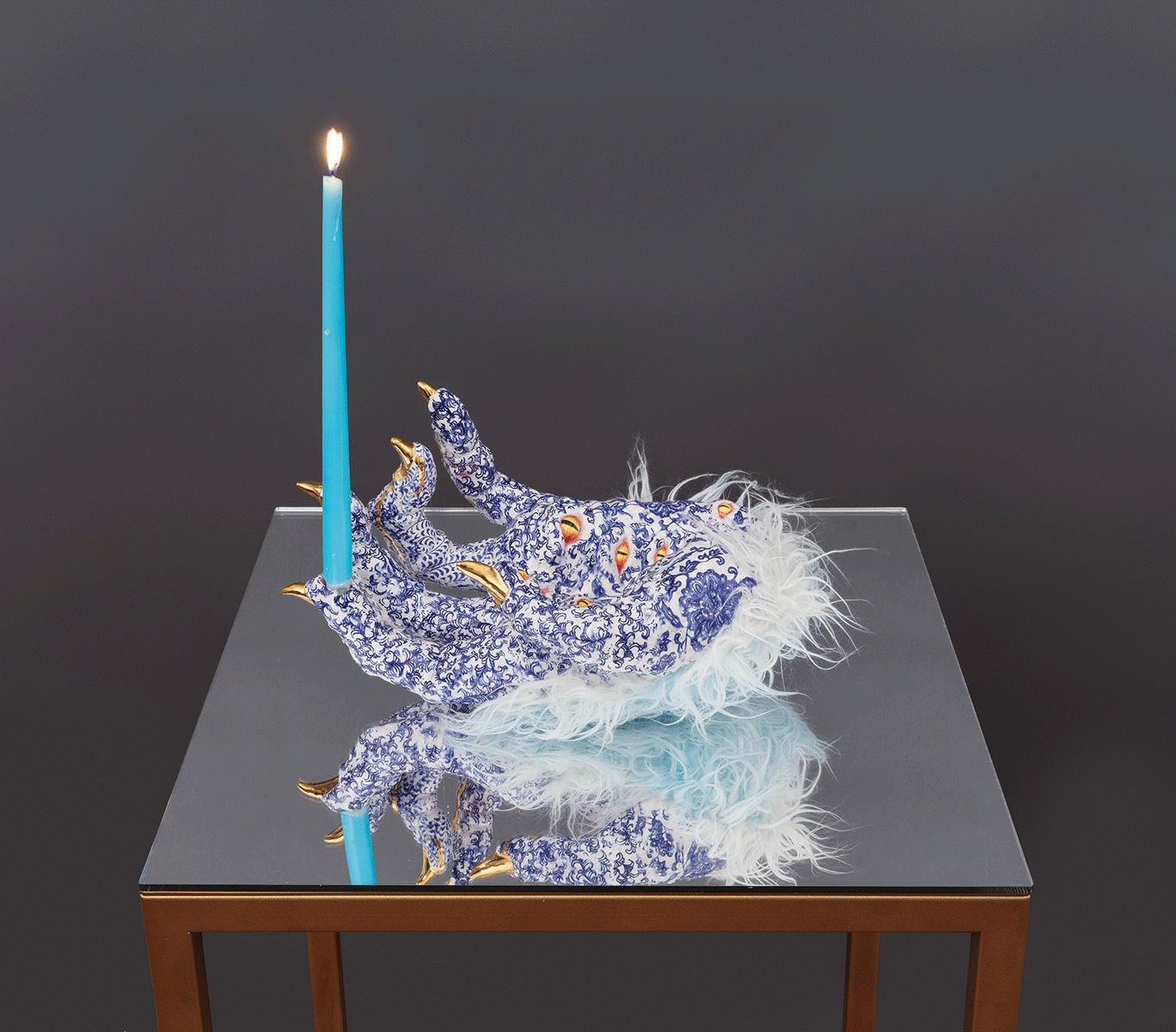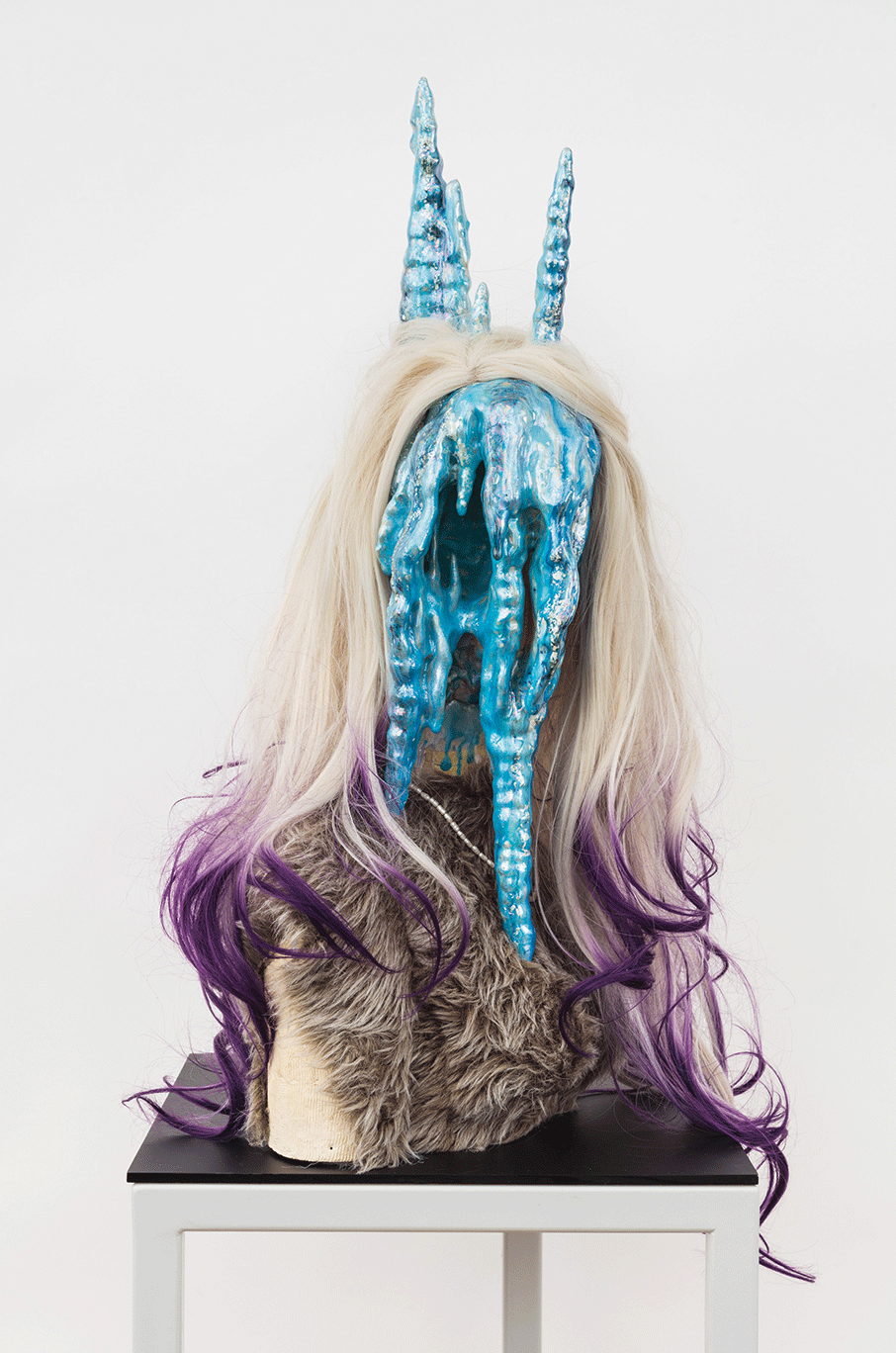« Reviews
KARMA
Duve Gallery - Berlin
Roxanne Jackson, High Priestess of the Fray
By Sarah Walko
“All living souls welcome whatever they are ready to cope with; all else they ignore,
or pronounce to be monstrous and wrong, or deny to be possible.”
George Santayana
Doctors and healers know their treatments, procedures, recommendations, medicines and even their wisdom, help create an environment in which the body can heal itself. Casts do not heal broken bones, they hold them. The bones do the work of growing back together. The human body, when functioning correctly, is a magical, self-healing organism. Roxanne Jackson’s animated sculptures of body parts, wildly colorful splayed skulls, creature palms and paws, are often more bestial than human. Made with the uncompromisingly hard material of ceramics, they sit like remnants of casts that were on your now-healed bones, familiar and yet still a haunting memory of the break. They confront you with what you are ready to cope with absolutely. But they also confront you with what you’d like to evade, declare wrong and claim impossible, all at once, whether you like it or not.
In the piece Bedroom Eyes, a blond-and-purple-haired figure with shoulders draped in stylish fur casts her gaze towards you. But her face has melted into an iridescent blue glaze and frozen, mid-melt. The face drips stand poised to land on her chest. From her head, blue stalagmites rise from the dual-colored locks like menacing traffic cones. This piece, like so much of Jackson’s work, holds a special power with a silent but intimidating authority. In the piece Delft Punk, a monstrous paw is decorated in the tin-glazed delft style, referencing the long history of ceramics and then amplified with bedazzled gold fingernails, blue fur and many fiery eyes peppered across the palm. One lone blue candle extends from the index finger, announcing something sacred is about to take place. You wait for it.

Roxanne Jackson, Delft Punk (Left Paw), 2019, ceramic, glaze, luster, faux fur, candle, rhinestones, 16” x 19” x 11.”
In The Wild Places, Robert Macfarlane wrote, “There is no mystery in this association of woods and otherworlds, as anyone who has walked the woods knows, they are places of correspondence, of call and answer. Visual affinities of color, relief and texture abound. A fallen branch echoes the deltoid form of a streambed into which it has come to rest. Chrome yellow autumn elm leaves find their color rhyme in the eye-ring of the blackbird. Different aspects of the forest link unexpectedly with each other, and so it is that within the stories, different times and worlds can be joined.” In the forest of Jackson’s work, there are stories within stories of these characters and creatures, jarring collisions of differing worlds, some severing. And there is a correspondence within them that includes the viewer. There is a call put out, waiting for a response. Perhaps said more succinctly and with an appropriate pop cultural wink, when walking into a roomful of her work, they greet you with “Welcome to the cultural jungle.” Disorienting, hilarious, sexy, horrid, these vessels seem to hold a strange wisdom, that they would just as easily keep from you as they would hand you based on a roll of the dice. Their seduction is unavoidable. The shiny, sexy surfaces of body parts call you close for their color and impeccable construction. They also call you in because you are unable to make out what you are actually looking at or you are trying to determine if that is an eyeball freshly sprung from a head or a fleshy finger. And you want to touch them. Once you are close, they reveal all kinds of secrets in the body and in our humanity, a reminder of when Oscar Wilde infamously said, “Everything in the world is about sex except sex. Sex is about power.”
In cultures that created many gods for their belief systems, the level of energy that is represented often determined the character of the god. For example, there are gods of compassion, gods of violence and gods of justice. There are gods who are the protectors of kings as they wage their war campaigns.

Roxanne Jackson, Bedroom Eyes, 2018, ceramic, glaze, luster, wig, freshwater pearls, faux fur, 16” x 28” x 11.”
These are personifications of the energy that’s in play, and some religions concretized these personifications, moving them beyond metaphors for the energies that are afflicting and guiding us. Other cultures created gods that are elemental, less human and more the powers of nature that a deity could represent. These could also represent human energy systems like love and malice, hate and benevolence.
Our brains want and need to categorize, and if it were not for our brains, our eyes wouldn’t be able to process anything. Our brains are constantly dealing with the influx of visual data, categorizing it and organizing it so we can function in the world. It makes sense that it is our tendency to personify rather than statically label transcendent mysteries, energies, emotions and beliefs.
Filmmaker Werner Herzog once said, “The human soul is a vast abyss, to look right at it, you’d get vertigo.” By personifying, we allow for the complexities inherent to every human being-all the talents and flaws in each of us, the unfailing contradictions, the unimaginable beauty, the shivering reality of the violence we are each capable of. And the energy of all of this lives in our own bodies, in the different organs in our bodies, including our head, where the alignments or conflicts reside. When it comes to making a decision, there will be a war, a decision to prioritize, decisions around possibilities of action informed by different energies and emotions. The gods and guides battle it out.
We have all experienced the many things present when wandering in a Roxanne Jackson exhibition: wonder, awe, confusion, agony, ecstasy. When they unfold in front of you, it feels like they are all just different divinities, from the point of view of a symbolic imagining. They are the story of our lives within the larger stories of the world, the many bodies we inhabit as we grow and change, break and mend, fluctuate between the ocean of emotions available to us each day. As Toni Morrison said, “Make up a story… For our sake and yours forget your name in the street; tell us what the world has been to you in the dark places and in the light. Don’t tell us what to believe, what to fear. Show us belief’s wide skirt and the stitch that unravels fear’s caul.”
Jackson’s sculptures ask us to show them that we have indeed lived, in all of life’s beauty and brutality. They ask us to splay our skulls open like a book so we can read our stories. They ask us to bear witness to when we were each struck with understanding and know there is something here that’s much bigger than the human dimension as we walk in our small shoes. They ask us to show them all the times when we took ourselves too seriously and when we confused the monster with the angel and when we were, each, both. They point out the construction of culture as they transmogrify in front of our eyes, exposing the underlying nature, actively beneath.
Robert Macfarlane also wrote, “All travelers to wild places will have felt some version of this, a brief blazing perception of the world’s disinterest. In small measures it exhilarates. But in full form it annihilates.” All travelers to wild places, including wild places within the mind and consciousness, will need the ability to hold space with all of it, the exhilaration and the annihilation. But it is the call to participate actively, with an aliveness, despite how scary it is, that is the call in this sculpture jungle. And as Phil Cousineau wrote, “The object of pilgrimage is not rest and recreation, to get away from it all. To set out on pilgrimage is to throw down a challenge to everyday life. Traveler, there is no path. Paths are made by walking. Put the soles of your feet to the soul of the world. Dawn is breaking. It’s time to head out.”
Jackson’s work reminds us we are all travelers, born into a pilgrimage, here for one iridescent flash of a moment wearing belief’s wide skirt. Throw down the challenge to everyday life. Walk straight into the exquisite fray, slaying fear. See what rises.
(September 13 - October 25, 2019)
Sarah Walko is an artist, director, independent curator and writer. She is currently the director of education and community engagement at the Visual Arts Center of New Jersey.
Filed Under: Reviews



































Leave a Reply
You must be logged in to post a comment.